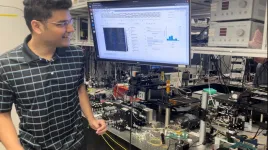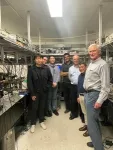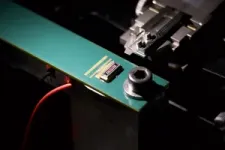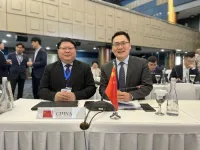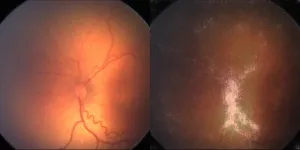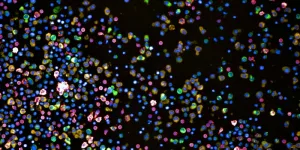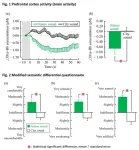(Press-News.org) WASHINGTON — Researchers have developed a new light-based computing scheme that uses a photonic integrated circuit to reduce the energy necessary for cryptocurrency and blockchain applications. Mining cryptocurrencies like Bitcoin—a process of verifying transactions and adding new cryptocurrency to the blockchain—consumes up to 1% of the world’s energy. This energy expenditure is expected to grow as cryptocurrency and blockchain applications become increasingly mainstream.
Cryptocurrencies are digital currencies created using encryption algorithms. These alternative currencies require a blockchain—a type of digital ledger that records information such as transactions in a way that is difficult or impossible to change or hack.
“Currently, cryptocurrency mining is only accessible to those that have access to highly discounted energy—below $0.05/kWh,” said first author Sunil Pai, who performed the research at Stanford and is now at the quantum computing company PsiQuantum. “Our low-energy chips will make it possible for individuals all over the world to participate in mining profitably.”
In Optica, Optica Publishing Group’s journal for high-impact research, the researchers detail their new scheme called LightHash, which uses a photonic integrated circuit to create a photonic blockchain. With further development, the researchers predict that this approach, if implemented on a large scale, could produce a roughly ten-fold improvement in energy use compared to the best modern digital electronic processors. David A.B. Miller co-led the Stanford University research team with Shanhui Fan and Olav Solgaard.
“Our approach to photonic blockchain could also be used for applications beyond cryptocurrency such as securely transferring data for medical records, smart contracts and voting,” said Pai. “This work paves the way for low-energy optical computing, which, ultimately, can reduce data centers’ energy consumption.”
Greener mining with silicon photonics
Growing concerns about the large amount of energy required to mine cryptocurrencies have caused some popular ones such as Ethereum to shift to unproven and potentially insecure schemes to minimize their carbon footprint.
To find a more eco-friendly approach while maintaining a high level of security, Pai and colleagues use silicon photonics to reduce the energy requirements of cryptocurrency networks. LightHash improves upon a scheme the team previously developed called HeavyHash that is currently used in cryptocurrency networks such as Optical Bitcoin and Kaspa.
“The major motivation for LightHash was HeavyHash’s high sensitivity to hardware error,” said Pai. “Since analog computers, including photonic ones, struggle to achieve low error rates, we designed LightHash to maintain all the security properties of HeavyHash, while improving its robustness to error.”
Securely creating Bitcoin or operating its computing network requires computing a hash function like SHA256 or Heavyhash to transform input data into a single output number in a way that is too complex to be undone, which accounts for the bulk of Bitcoin’s energy use. In the new work, the researchers modified Heavyhash to work with a co-designed silicon photonic chip carrying a 6x6 network of programmable interferometers. This enabled low-energy optical processing of matrix multiplications, which forms the bulk of the computation in Lighthash.
To evaluate the feasibility of using LightHash for matrix multiplication, the researchers built an optical rig to control and track the propagation of light by tuning heating elements and imaging grating spots onto an infrared camera. They also implemented an error mitigation algorithm and established feasibility criteria for scaling the technology.
Precise, lower-power computation
The experimental results achieved with the silicon photonic chip matched those obtained using simulated error predictions. “Our results suggest that LightHash can be feasibly computed at scale using current silicon photonic chip technology,” said Pai. “Essentially, we have devised a way to use analog optical circuits to perform multiplications at near zero power dissipation yet precisely enough for use in a digital encryption scheme.”
For LightHash to demonstrate considerable advantages over digital equivalents, it must be scaled up to 64 inputs and outputs. The researchers are also working to further reduce energy consumption by designing low-power electromechanical tuning elements and energy-efficient converters to turn the optical signals into electrical signals.
They say that because the new chip accelerates matrix multiplication, the most computationally intensive operation for AI applications, it could also help make training and application of photonic neural networks more energy efficient compared to conventional digital implementations.
“It will be interesting to see how cryptocurrency technology evolves and to what extent photonics can contribute to the increasingly mainstream role of decentralized ledgers in society today,” said Pai.
Paper: S. Pai, T. Park, M. Ball, B. Penkovsky, M. Dubrovsky, N. Arebe, M. Milanizadeh, F. Morichetti, A. Melloni, S. Fan, O. Solgaard, D. A. B. Miller, “Experimental evaluation of digitally-verifiable photonic computing for blockchain and cryptocurrency,” 10, 4 (2023).
DOI: 10.1364/OPTICA.476173
About Optica
Optica is an open-access journal dedicated to the rapid dissemination of high-impact peer-reviewed research across the entire spectrum of optics and photonics. Published monthly by Optica Publishing Group, the Journal provides a forum for pioneering research to be swiftly accessed by the international community, whether that research is theoretical or experimental, fundamental or applied. Optica maintains a distinguished editorial board of more than 60 associate editors from around the world and is overseen by Editor-in-Chief Prem Kumar, Northwestern University, USA. For more information, visit Optica.
About Optica Publishing Group (formerly OSA)
Optica Publishing Group is a division of the society Optica (formerly OSA), Advancing Optics and Photonics Worldwide. It publishes the largest collection of peer-reviewed content in optics and photonics, including 18 prestigious journals, the society’s flagship member magazine, and papers from more than 835 conferences, including 6,500+ associated videos. With over 400,000 journal articles, conference papers and videos to search, discover and access, Optica Publishing Group represents the full range of research in the field from around the globe.
END
Light-based computing scheme reduces power needed to mine cryptocurrencies
New photonic blockchain could make cryptocurrencies more accessible and enable low-energy optical computing
2023-04-27
ELSE PRESS RELEASES FROM THIS DATE:
CityU establishes the first UNESCO Regional Training and Research Centre on coastal contaminant monitoring in Hong Kong for the Western Pacific region
2023-04-27
The State Key Laboratory of Marine Pollution (SKLMP) of City University of Hong Kong (CityU) received approval from the UNESCO Intergovernmental Oceanographic Commission (IOC) Sub-Commission for the Western Pacific (WESTPAC) to establish the first UNESCO regional training and research Centre (the Coastal-COMMIT Centre, also known as the “Centre”) on coastal contaminant monitoring and marine innovative technologies in Hong Kong for the Western Pacific region.
The Centre aims to strengthen the monitoring capacity for marine pollution in the Western Pacific region, promote the development of marine innovation ...
James Fast selected as Jefferson Lab EIC project manager
2023-04-27
NEWPORT NEWS, VA – Scientists at the U.S. Department of Energy's Thomas Jefferson National Accelerator Facility and DOE’s Brookhaven National Laboratory partnered early on to take on the design and construction of the Electron-Ion Collider. To keep the project moving forward, Jefferson Lab tapped members of its experienced leadership team to ensure project success. Now, Jefferson Lab is proud to announce it has appointed a dedicated EIC project manager: James Fast will lead the lab’s EIC project team and honor the lab’s project commitments going forward.
“The EIC project is central to the future of ...
AI breakthrough in detecting leading cause of childhood blindness
2023-04-27
The team developed a deep learning AI model that can identify which at-risk infants have ROP that may lead to blindness if left untreated, and they hope their technique could improve access to screening in the many areas with limited neonatal services and few trained ophthalmologists.
The study, by an international team of scientists and clinicians in the UK, Brazil, Egypt and the US, supported by the National Institute for Health and Care Research (NIHR) Biomedical Research Centre at Moorfields Eye Hospital NHS Foundation Trust and UCL Institute of Ophthalmology, is published in The Lancet Digital Health.
Lead author Dr Konstantinos Balaskas ...
Why people include themselves in photos
2023-04-27
Embargoed until 9 AM ET on Thursday, April 27, 2023
COLUMBUS, Ohio – A new study may help explain why people choose to include themselves in some photos – and it is not vanity.
Researchers found that first-person photos (capturing the scene as it looks from one’s own eyes) best represent the physical experience of an event for people.
But third-person photos like selfies (documenting a moment with themselves in it) better depict the deeper meaning of the event in their lives.
“We found that people have a natural intuition about which perspective to take to capture what they want out ...
Selfies and other third-person photos help us capture the meaning of moments
2023-04-27
Imagine you are eating your dream meal and want to commemorate the moment: Should you snap a picture of the food by itself or take a selfie with your partner while you eat? New research suggests that people use first-person photography, taking a photo of the scene from one’s own perspective, when they want to document a physical experience, but opt for third-person photos, depicting themselves in the scene (like selfies), to capture the deeper meaning of events.
Previous research has focused how the photo-taker wants to present themselves to others. The current research, published today in Social Psychological and Personality Science, ...
How can we fight blood cancer more effectively?
2023-04-27
Multiple myeloma is a rare blood cancer caused by the uncontrolled multiplication of abnormal plasma cells. These plasma cells are a special type of white blood cells that play an important role in the immune system by producing essential antibodies in the bone marrow and lymph nodes.
Despite an increasing number of approved drugs and treatment approaches such as immunotherapy becoming available, the disease is still not curable. The average life expectancy of patients after diagnosis is only five years.
One of the main challenges is the cancer’s tendency to return even after treatment. This is because treatment makes the cancer cells ...
Researchers call for national governments to mandate real-time indoor air quality monitoring
2023-04-27
In a response to the COVID-19 pandemic, a team of researchers has published an editorial calling for national governments to consider mandating real-time indoor air quality monitoring in at least all public buildings.
Their editorial is published in the journal Building Simulation on 25 April 2023.
The three-year-long COVID-19 pandemic, caused by the severe acute respiratory syndrome coronavirus 2 (SARS-CoV-2), has revealed that there is a global indoor-air crisis. Vaccination alone has not completely controlled the COVID-19 pandemic and the virus continues to threaten human health and life. Scientists now know most if not nearly all ...
Routine antibiotics don't improve outcomes of post-mastectomy breast reconstruction
2023-04-27
April 27, 2023 – For breast cancer patients undergoing breast reconstruction after mastectomy, avoiding postoperative oral antibiotics does not reduce the risk of infections, reports a study in the May issue of Plastic and Reconstructive Surgery®, the official medical journal of the American Society of Plastic Surgeons (ASPS). The journal is published in the Lippincott portfolio by Wolters Kluwer.
"Our experience suggests that discontinuing routine oral antibiotic treatment after implant-based breast reconstruction ...
MD Anderson and Generate:Biomedicines enter co-development and commercialization agreement to accelerate novel protein therapeutics for oncology using generative AI
2023-04-27
HOUSTON and SOMERVILLE, Mass. ― The University of Texas MD Anderson Cancer Center and Generate:Biomedicines today announced a strategic collaboration to jointly discover and co-develop protein therapeutics for up to five oncology targets in advanced cancers, including small-cell and non-small-cell lung cancer.
Under the co-development and commercialization agreement, MD Anderson and Generate:Biomedicines will each contribute toward creating optimized, potentially best-in-class therapeutics that can rapidly advance into proof-of-concept clinical trials. The agreement combines Generate:Biomedicines’ integrated machine-learning capabilities and experimental/wet lab capabilities – ...
Sounds from nature: A soothing remedy for gambling addiction
2023-04-27
Gambling addiction, also called “pathological gambling” and “gambling disorder (GD),” is known to have severe economic, social, mental, and physical consequences on those affected. One of the major factors contributing to the development and relapse of this disorder is stress. However, studies show that replacing gambling with alternative leisure activities may reduce the likelihood of developing the disorder. In recent years, forest bathing, or “shinrin-yoku,” a form of nature therapy, has emerged ...
LAST 30 PRESS RELEASES:
Injectable breast ‘implant’ offers alternative to traditional surgeries
Neuroscientists devise formulas to measure multilingualism
New prostate cancer trial seeks to reduce toxicity without sacrificing efficacy
Geometry shapes life
A CRISPR screen reveals many previously unrecognized genes required for brain development and a new neurodevelopmental disorder
Hot flush treatment has anti-breast cancer activity, study finds
Securing AI systems against growing cybersecurity threats
Longest observation of an active solar region
Why nail-biting, procrastination and other self-sabotaging behaviors are rooted in survival instincts
Regional variations in mechanical properties of porcine leptomeninges
Artificial empathy in therapy and healthcare: advancements in interpersonal interaction technologies
Why some brains switch gears more efficiently than others
UVA’s Jundong Li wins ICDM’S 2025 Tao Li Award for data mining, machine learning
UVA’s low-power, high-performance computer power player Mircea Stan earns National Academy of Inventors fellowship
Not playing by the rules: USU researcher explores filamentous algae dynamics in rivers
Do our body clocks influence our risk of dementia?
Anthropologists offer new evidence of bipedalism in long-debated fossil discovery
Safer receipt paper from wood
Dosage-sensitive genes suggest no whole-genome duplications in ancestral angiosperm
First ancient human herpesvirus genomes document their deep history with humans
Why Some Bacteria Survive Antibiotics and How to Stop Them - New study reveals that bacteria can survive antibiotic treatment through two fundamentally different “shutdown modes”
UCLA study links scar healing to dangerous placenta condition
CHANGE-seq-BE finds off-target changes in the genome from base editors
The Journal of Nuclear Medicine Ahead-of-Print Tip Sheet: January 2, 2026
Delayed or absent first dose of measles, mumps, and rubella vaccination
Trends in US preterm birth rates by household income and race and ethnicity
Study identifies potential biomarker linked to progression and brain inflammation in multiple sclerosis
Many mothers in Norway do not show up for postnatal check-ups
Researchers want to find out why quick clay is so unstable
Superradiant spins show teamwork at the quantum scale
[Press-News.org] Light-based computing scheme reduces power needed to mine cryptocurrenciesNew photonic blockchain could make cryptocurrencies more accessible and enable low-energy optical computing
